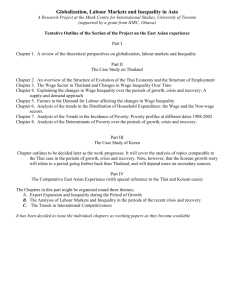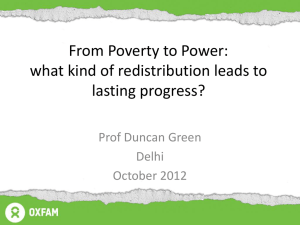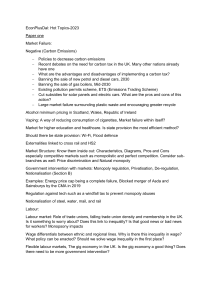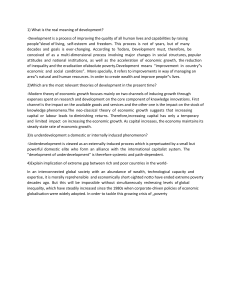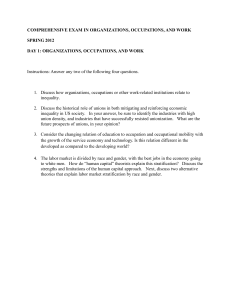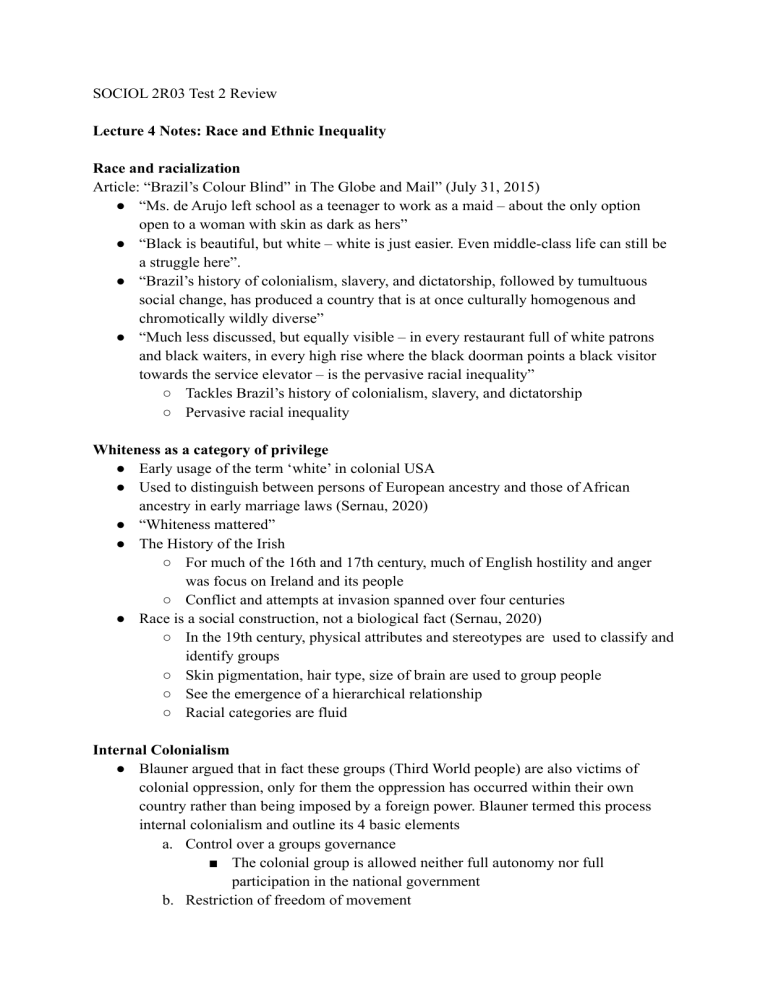
SOCIOL 2R03 Test 2 Review Lecture 4 Notes: Race and Ethnic Inequality Race and racialization Article: “Brazil’s Colour Blind” in The Globe and Mail” (July 31, 2015) ● “Ms. de Arujo left school as a teenager to work as a maid – about the only option open to a woman with skin as dark as hers” ● “Black is beautiful, but white – white is just easier. Even middle-class life can still be a struggle here”. ● “Brazil’s history of colonialism, slavery, and dictatorship, followed by tumultuous social change, has produced a country that is at once culturally homogenous and chromotically wildly diverse” ● “Much less discussed, but equally visible – in every restaurant full of white patrons and black waiters, in every high rise where the black doorman points a black visitor towards the service elevator – is the pervasive racial inequality” ○ Tackles Brazil’s history of colonialism, slavery, and dictatorship ○ Pervasive racial inequality Whiteness as a category of privilege ● Early usage of the term ‘white’ in colonial USA ● Used to distinguish between persons of European ancestry and those of African ancestry in early marriage laws (Sernau, 2020) ● “Whiteness mattered” ● The History of the Irish ○ For much of the 16th and 17th century, much of English hostility and anger was focus on Ireland and its people ○ Conflict and attempts at invasion spanned over four centuries ● Race is a social construction, not a biological fact (Sernau, 2020) ○ In the 19th century, physical attributes and stereotypes are used to classify and identify groups ○ Skin pigmentation, hair type, size of brain are used to group people ○ See the emergence of a hierarchical relationship ○ Racial categories are fluid Internal Colonialism ● Blauner argued that in fact these groups (Third World people) are also victims of colonial oppression, only for them the oppression has occurred within their own country rather than being imposed by a foreign power. Blauner termed this process internal colonialism and outline its 4 basic elements a. Control over a groups governance ■ The colonial group is allowed neither full autonomy nor full participation in the national government b. Restriction of freedom of movement ■ Colonial peoples are not willing immigrants but are involuntaryly incorporated into the national society. Often their ability to choose where they live and work is severely restricted c. Colonial type of labour exploitation ■ A “cultural division of labour” exists in which the colonial peoples are assigned to be the most enial or dangerous work and given the least compensation for that work d. Belief in group’s inferiority ■ In this model, prejudice follows from, target than causes, discrimination. The exploitation of the colonial group must be justified, and this is done through an ideology that asserts the group’s moral, intellectual, and cultural inferiority. Thus the domination of the group’s members by the others is “for their own good”. First Nations in Canada ● Indian Act 1876 ○ The act restricts Indigenous freedoms and allowed officials to determine Indigenous rights and benefits based on ‘good moral character’. ○ It is considered as an assimilation into a non-Indigenous society towards a vast and varied population of First Nations. ● Powerful lasting effects on the lives of Native people ● “A woman married to anyone other than an Indian was not entitled to status as an Indian, nor were her children…” ● Patriarchal laws that destroyed matrilineality of many Native families ● History of Residential schools since 1840s, last school closing in 1996 ● Sixties Scoop 1951 ○ Between the 1960s and the 1980s, the “Sixties Scoop” removed First Nations, Metis, and Inuit children from their homes, often without consent, warning, or even knowledge of the childrens’ families and communities Native Americans (Sernau, 2020) ● Attempts to assimilate and attempts to annihilate ● Dawes Allotment Act of 1887: reservation of 40 acre plots ● With few exceptions, Native population of the Eastern United States were moved westward ● “The cruelty directed toward the Native Americans is best seen not as uniquely American ruthlessness but as the American version of empire building of the time”. ○ “The little children are freezing to death. My people, some of them, have ru away to the hills and have no blankets, no food; no one knows where they are– perhaps freezing tp death… hear me, my chiefs. I am tired; my heart is sick and sad. From where the sun now stands I will fight no more forever” ○ This is a characteristic of the treatment of First Nations and Inidgenous peoples globally African Americans ● US ended slavery in 1865 (patterns of internal colonialism remained in place ● Ontario (and a Colony of Upper Canada) ended slavery in 1793 ● History of the plantation economy and racial - caste system (there was no room to move up and/or out) ○ The term caste refers to an intergeneratioal system of racial or ethic divisions that determine an individual’ss place in society. In a caste system, there is almost no room for upward mobility ○ Enduring racial hierarchy that has persisted for centuries ○ Segregation controlled African American’s movements, wage and job discrimination continued their labor exploitation, voting restrictions limited their self-government, and stereotypes about them persisted. ● Role of Thomas Jefferson: knew slavery was immoral but was conflicted on course of action ● 1964 civil rights act ○ “Is a landmark civil rights and labor law in the United States that outlaws discrimination based on race, color, religion, sex, and national origin” In Canada: ● 20s-40s: british Isles and NorthWestern Europe (made up of 72% of immigrants) ● 45s-66: South East Europe ● Mid 1960s - present: Rise in Asian immigrants In US ● Specific history of Hispanic American ● Cuban Americans and Puerto Ricans speak directly of American imperialism expansion (Puerto Ricans not considered an immigrant group) Culture of Poverty ● “The culture of poverty, however, is not only an adaptation to a set of objective conditions of the larger society. Once it comes into existence, it tends to perpetuates itself from generation to generation because of its effect on the children. By the time slum children are age six or seven, they have usually absorbed the basic values and attitudes of their subculture” ○ People in poverty develop certain habits that cause their families to remain in poverty over generations. These habits lead people in poverty to make choices that eventually lead to their continuation in the poverty system. ○ Poor families develop fatalistic values and attitudes ○ Self-fulfilling prophecy, poverty causes more poverty ○ Deferred gratification vs immediate gratification ○ Cultural traits rooted in overall structure ○ Coined by Oscar Lewis ● Great discrepancy/disconnect between the country’s ideals of freedom and equality and the reality that it was built on racial oppression and inequality Social Reproduction of Poverty: 1. Culture of poverty puts the blame on the poor 2. Ignores or minimizes the structural basis of property 3. Ignores the history of many groups Structural Causes of Poverty ● Loss of manufacturing jobs ● Expansion of service work ● Increase in precarious work ● Increase in low-paying jobs ● Increase in unemployment and underemployment Middleman Minorities and Ethnic Solidarities ● “Middleman groups, with their persistent upward mobility, may be accepted by dominant groups, even seen as “model minorities”, but they often incur the hostility of the people they serve. ○ I.e. Family-operated businesses may rarely hire people from the neighborhoods in which they are located, and such businesses can be seen as exploiting or profiting from the hardships and limited opportunities of the neighborhoods they serve ● Mobilizing ethnic solidarity within close-knit grops ● A culturally or racially distinct group immigrates and suffers discrimination ● Work closely together in small businesses in poor neglected areas (i.e. owners of small groceries, liquor stores, laundries, small motels, variety shops) ● One of the key peculiarities is the economic role they play. They concentrate in certain occupations and play the role of the “middleman”. 1967 points system: basis of education, occupational skills and knowledge of the official language ● Immigrants coming to Canada in recent years have educational levels far higher than that of other Canadians Lecture 5 Notes: Gender Inequality Masculinity as both a privilege and a vulnerability ● It is a category of privilege a. In power (democracy) b. Economic privilege (private ownership of property) c. Prestige (special advantages) d. Positions of power ● William Goode (1992) “Sociology of Superordinate) a. Understands the worlds of the ‘other’ b. Disconnect with the histories c. Taking for granted the structure d. Self-congratulate (not recognize their privilege) e. Not notice the talents of those below f. Those at the rarely recognize social structures that advantage them Women and the Victorian Ideal ● Nancy Cott (2001) “cult of domesticity” ○ Strengthened and solidified women’s positioning and function in the home ○ Rise in discourse on women’s place in the home ○ The ideology of the Victorian era was that a woman’s place was at home (Lindsey, 2015) ● Role of Industrialization ○ Created two distinctions between men and women’s work ○ Employers organized time and set pay based on the assumption that the workers were men – 20th century union movement supported the family wage ○ Sexual division of labour: men and women segregated into different jobs, different occupational spaces (remember any form of segregation enables inequality) ● Ideology of the separate spheres ○ Called for a separation of family life from paid work ● Industrialization: labour force became increasing male throughout the 19th century ○ In 1840, women and children made up 40% of industrial workers ○ In 1870, 3 out of 4 industrial workers pay outside the home (Goldin, 1990) ○ In 1920… ■ 7% of married European-American Women were in the labour force ■ 18% of married Asian-American women ■ ⅓ of married African-American womn in the labour force Women’s Labour Force Participation ● Causes of Female Participation Rate Changes ○ Both immediate and underlying causes ○ Immediate causes of LFP changes ■ 60s and 70s availability of more jobs ■ Policy issues ■ 80s more women with preschool children entering the LF ● Need for family income ● Rise in education ■ New policies around childcare ■ Representation by trade unions ■ 90s leveling of due to recession ■ 2000 rise in economic opportunities Gender inequality and inequality in the workplace Gender and Earnings-accounting for women’s lower earnings ● Earning ratio: women’s average or median earnings by men’s ● Earnings: Total money you make in agiven period (usually a year) - wages (your hourly rate) ● Occupational Gender Segregation: refers to the concentration of men and women in different occupations, industries, jobs and levels in workplace hierarchies ● Two factors seems imortant: a. Occupation determines wage rate b. Women are concentrated into lower paying occupations ■ Thus: differences in occupational concentration leads to differences in wages ● In 2018, female employees aged 25 to 54 earned $4.13 (or 13.3%) less per hour, on average, than their male counterparts. In other words, these women earned $0.87 for every dollar earned by men ○ The reduction in the gender wage gap between 1998 and 2018 was largely explained by changes in 1. The distribution of men and women across occupations; 2. Women’s increased educational attainment; 3. Decline in the share of men in unionized employment ○ Two largest factors explaining the remaining gender wage gap in 2018 were: 1. The distribution of women and men across industries and 2. Women’s overrepresentation in part time work ● The Gender Wage Gap in Canada: 1998 to 2018 ○ The decrease in the wage gap occurred in a somewhat step-wise manner over the period, with sharper declines observed during theearly 200s and around the 20098-2009. Both of these decreases reflect periods of stagnant or declining wages among men, rather than notable increases in women’s wages ○ Variables to consider: ■ Human capital ■ Job Attributes ■ Occupational Segregation ■ Demographics ● Women currently earn about 77 cents for every dollar earned by men (Sernau, 2020) ○ Pay gap over the life span of a woman ○ Pay gap within occupations ○ Men outearn women in almost all occupations except the top category of judges (although this is still a male dominated field) ● Persistence and representation of women in STEM programs by Katherine Wall (Statistics Canada May 2019) ○ 2016 women made up of 34% of STEM Bachelor’s degree holders and 23% of science and technology workers among Canada aged 25-64 ○ Women’s share of enrolments in STEM degree programs remained relatively stable between 2010 and 2015 ○ Women’s representation is lowest in engineering and computer science fields (where a large majority of science and technology jobs are concentrated). ○ Women beginning to outnumber men at most medical schools; 56% of first year medical students in 2017/18 were female; 44% were male. Total enrolment in 2017/18 was 11, 737; number of graduates in 2018 was estimated at 2, 860. Number of residents in postgraduate programs in 2018/19 was 16, 508. ● On average women allocate more effort to work than do men ○ “Women worked longerm dd more work, completed more correct work, and were more efficient than men” from Major et al. study 1984 ○ Women generate energy necessary to fulfill their commitments to two sets of activity ○ Work demands of the home do not impact negatively ● Hennig and Jardim (1977), The Maagerial Woman ○ Pointed to differential socialization ○ If women behaved like men, they would advance ● Rosabeth Moss Kanter (1977), Men and Women of the Corporation ○ Demographic structure of the corporation ■ Token- skewed groups-dynamcs of tokenism ○ Power structure of the corporation ○ Opportunity structure of the corporation ● KEY POINTS: ○ Historical shifts in Labour Force Participation ○ While the roles of women are changing, women remain concentrated in low paying occupations ○ Women earn less than men on average and have limited access to the top positions (wage gap and promotions gap) ○ Women remain responsible for domestic work despite their entrance into the paid labour force (this has LFP implications) ○ Be familiar with the work of Hennig and Jardim 1977/and Rosabeth Moss Kanter Lecture 6 Part 1 Notes: Status Prestige Status ● In a capitalist society, class is foremost about money. In an agrarian society, class is about family and land. ● Yet in both kinds of societies, the class stratification system also includes a subjective element: how one lives and how one is seen by others. ● Status oriented behaviour ○ Value rational behaviour ○ Status oriented lifestyles ○ Power Social Class ● An individuals class situation is ultimately a market situation (Marx and Weber) ● Education, occupation, income constitutes to Socioeconomic Income Prestige ● Is passed on and acquired in many different ways ● Prestige in such cases is based on personal charisma, bravado, and leadership. ○ Prestige built on charisma can be translated into other forms of privilege ● Both prestige and respect are examples of social exchange ○ True of agrarian times but also true of contemporary times ○ What family you belong to confers prestige ● Occupational Prestige ○ Scale of occupational prestige is a ranking of social status based on people’s subjective interpretations ○ Money matters, but status distinctions go beyond just income Example: the income of a unionized Janitor in a school building may exceed the income of a new teacher in that building, yet, the teacher who has the most prestigious occupation based on education and type of work ● Parental Aspirations by Social Class ○ Kohn’s research (1977) on the attitudes and hopes for children held by families of different social classes ○ Parents attempts to prepare their children to assume expected roles (jobs/occupations) ○ Working class parents want children to be neat and clean and follow the rules (habits that will help them in blue collar work) ○ Middles class parents are more likely want to cultivate their children’s creativity, independence, and curiosity ○ Working class mothers make a clear distinction between sexes ○ “Race and gender assumptions may intermingle with class distinctions ■ Poor families and individuals can only get validation and social respect from local “gangs” or by a peer group. Unsatisfactory can lead to hostility or alienation. Cultural Capital ● Bourdieu ● The accumulated ability to appreciate “high art” and sophisticated cultural expressions constitutes as cultural capital ● Constitutes with symbolic, cultural, social ● Such tastes can be a justification for privilege: “others would not truly appreciate what we have anyway” ○ Social Capital: Individuals or families are trying to increase their assets and improve their social positioning ■ New job seekers to new immigrants may try to draw on the social capital embodied in their social networks to find better jobs, start businesses, advance their education, and gain economic advantages Habitus ● Coined by Pierre Boudieu (1944) ● “The habits of speech, work, lifestyle, and field of interest and appreciation thar determine where an individual feels comfortable, knowledgeable, and at “home” ○ “Mental structures through which individuals apprehend the social world” ● Low brow interests of the working class ○ Jokes about glow-in-the-dark Elvis paintings ○ Music interest most often related with rap, blues, and or country music ○ Distinctive outfit styles: grunge as it is associated with rural or urban poor ● Middle brow interests of the middle class ○ Associated with sports, watching as spectators ○ Music: pop and easy listening, even if it has elements of blues ○ Bourdieu categorizes photography as a middlebrow art ● Highbrow interests of the high class ○ Requires relatively extensive and exclusive socialization to appreciate ○ Moderate highbrow: impressionist art, golf at a private club, and classical music ○ Truly Highbrow: more “sophisticated”, abstract modern art, polo, and modern symphonic music or classical opera. ○ Symbolizes elitism and greater mark of distinction Conspicuous Consumption ● People purchase and consume goods, not because they need it, because they want to be seen as having it. ● Thornstein Veblen, 1899 ● Conspicuous Waste- seen in puffy sleeves and long trains at a time when fine cloth was expensive ● Conspicuous multiplication- is seen in the desire to wear a different outfit each day; reaches extremes in entertainers who never wear the same clothing twice ● Conspicuous leisure- “fit over function”. Wearing a three piece suit that is noteworthy yet difficult for physical mobility to do any manual labour in it. Lecture 6 Part 2 Notes: Power and Politics Power ● The ability to achieve one’s will in spite of opposition (Wbeer) ● Who Rules? ○ C. Wright Mills (1956) The Power Elite ■ Interwoven interests of the leaders of the military, corporate, and political elemts of society ■ Jogn Porter (1965) viewed the economic elite as the most powerful in Canada Pluralist Position ● Society is divided among varying interest groups ● Decisions ultimately depend on who can build coalitions ● To rule, Elites need to fina a way to coordinate their goals Class Consciousness ● Worker’s need to see their common position and the develop a sense of solidarity ● False consciousness- inability of those within a specific class to recognize their class position ● Class identity- an awareness of membership in a distinct class ● Class opposition- the belief that the interests of the workers and capitalists re inherently opposed Paradox of Democracy ● Increasing disillusionment with the political process and thus not exercising their voting rights Religion, Region, and Values ● The complexities of the religion divides in US voting were seen most strikingly in the 2016 election ● A full 80% of those white voters who described themselves as “born again” or “evangelical Christian” voted for Trump Global Power: eonomic trend has been toward globalization (rising power of corporations) Political Trend: toward democratization Main points: 1. There is an unequal distribution of power 2. Class consciousness is weak in US and Canada 3. Concentration of economic power in a small group of giant private sector corporations
